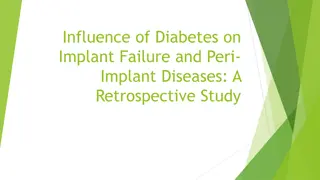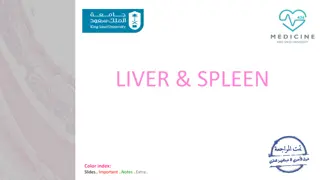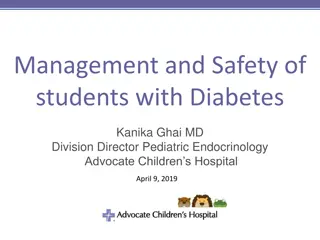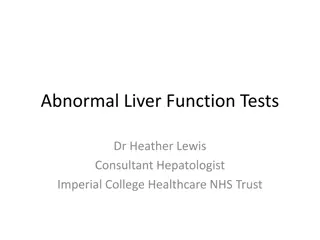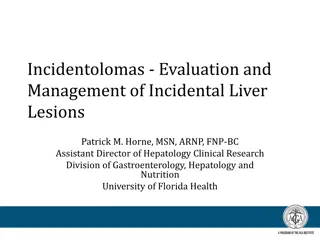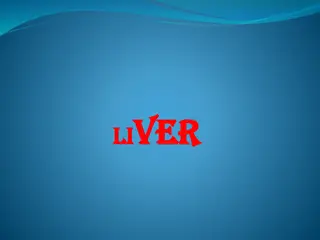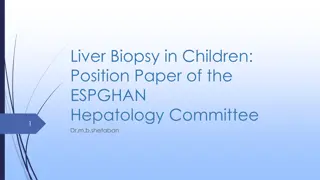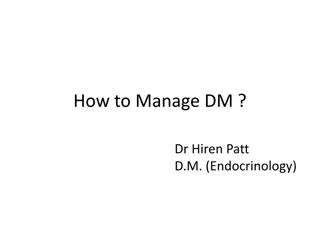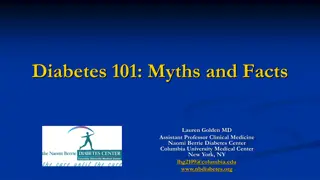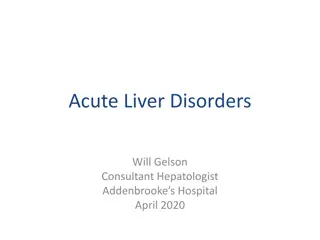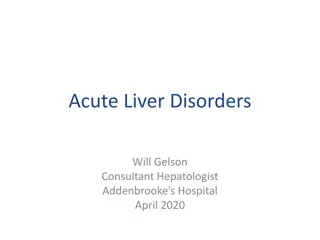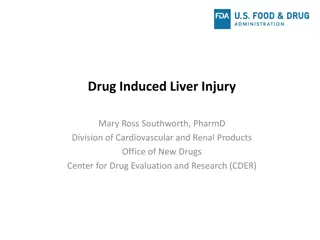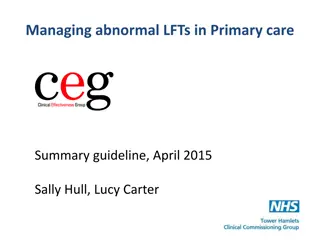Understanding Diabetes-Related Liver Diseases and Their Diagnostic Criteria
Explore the various liver diseases associated with diabetes, such as Glycogenic Hepatopathy, Diabetic Hepatosclerosis, and Hepatogenous Diabetes, along with their etiology, diagnosis, and management. Learn about rare conditions like Glycogenic Hepatopathy characterized by glycogen accumulation and how Diabetic Hepatosclerosis serves as a marker for severe diabetes. Discover Hepatogenous Diabetes developed as a complication of cirrhosis and the criteria for diagnosing diabetes in liver diseases.
Download Presentation

Please find below an Image/Link to download the presentation.
The content on the website is provided AS IS for your information and personal use only. It may not be sold, licensed, or shared on other websites without obtaining consent from the author. Download presentation by click this link. If you encounter any issues during the download, it is possible that the publisher has removed the file from their server.
E N D
Presentation Transcript
Diabetes and Liver Disease Dr.M.Movahedi Rad Endocrinologist
AGENDA Etiology of liver disease associated with diabetes. Diagnosis and management of diabetes in CLD NAFLD and Diabetes
: : : . NAFLD/NASH 1 /) ( : : Diabetic hepatosclerosis Glycogenic Hepathopathy )( : . Hepathogenous Diabetes 2 - : 3 .
Glycogenic Glycogenic hepatopathy hepatopathy(GH) (GH) GH is a rare under-recognized disease characterized by : Poorly controlled diabetes Acute liver injury with: marked elevation in serum aminotransferases and characteristic histological features on liver biopsy that include marked glycogen accumulation, no or mild fatty changes, no or minimal inflammation and intact architecture with no significant fibrosis . Pathophysiology of GH is : the wide fluctuation in glucose and insulin levels . GH typically presents in children and adolescents with T1 DM , but it can also be observed in adult T1 DM and recently reported in T2 DM. Glycaemic control is the only therapy needed for GH.
Diabetic Diabetic hepatosclerosis hepatosclerosis (DHS) (DHS) DHS is a noncirrhotic form of perisinusoidal fibrosis without steatosis observed in liver biopsies of people with diabetes. Occurs in : long-lasting T1 DM and T2 DM and microvascular disease in other organs, especially the kidney and has been proposed to represent the hepatic manifestation of diabetic microangiopathy. DHS is a marker of severe DM. Pathogenesis is due to : prolonged hyperglycemi increased AGEPs, leading to enhanced lipid peroxidation, with their byproducts inducing vasoconstriction and increasing platelet adhesion and aggregation.
Hepatogenous Hepatogenous Diabetes Diabetes Hepatogenous diabetes (HD) HD is a term used for DM developing as a complication of cirrhosis. Differentiation of hepatogenous DM from primary DM: HD has particular clinical characteristics: 1)It is more frequently associated with hypoglycaemic episodes as a result of impaired liver function, 2)It is less frequently associated with risk factors such as age, body mass index and family history of diabetes. Moreover, the time at diagnosis of both DM and liver disease is crucial in differentiation
Criteria for the diagnosis of diabetes associating liver disease The criteria for the diagnosis of DM associating liver disease and also prediabetes are the same as for the ordinary primary diabetes according to ADA. In the early stage of cirrhosis, fasting serum glucose levels is normal in 23% of patients, whereas post-prandial blood glucose may be <200 mg/L., thus an oral glucose tolerance test is needed. Fasting and 2 h post 75 g glucose blood sugar levels are required for diagnosis, the same as in those without CLD. However, the glycated hemoglobin (HbA1C) is unreliable for diagnosis or the monitoring of glycemic control in patients with cirrhosis
HbA1c must be used with caution for monitoring glycemic control in patients with cirrhosis and diabetes. HbA1c is an unreliable indicator of glycemic control in patients with cirrhosis and anemia and/or impaired liver function. Fructosamine is an unreliable indicator of glycemic control in patients with cirrhosis and hypoalbuminemia. Self-monitoring of capillary blood glucose appears to be a good alternative in patients with cirrhosis and moderately/severely impaired liver function. Continuous glucose monitoring can detect nocturnal hypoglycemia in patients with cirrhosis, especially those treated with anti-hyperglycemic drugs, such as sulphonylureas, glinides or insulin.
For patients with cirrhosis and preserved liver function, the current guidelines for T2DM management should be followed for glycemic target achievement, similar to patients without cirrhosis. In patients with cirrhosis and impaired liver function, prognosis is primarily driven by liver-related complications rather than diabetes complications. In patients with cirrhosis and moderately/severely impaired liver function, glycemic targets under insulin therapy should be adjusted to maintain pre-meal values between 100 and 200 mg/dL .
TREATMENT OF DM IN PATIENTS WITH TREATMENT OF DM IN PATIENTS WITH CHRONIC LIVER DISEASE CHRONIC LIVER DISEASE Biguanides: Metformin can be used in patients with cirrhosis and preserved/ slightly impaired liver function. Dosage should be adapted to renal function. Some studies suggest that metformin can reduce HCC occurrence in patients with cirrhosis. Metformin should be discontinued in patients with cirrhosis and moderately/severely impaired liver function.
TREATMENT OF DM IN PATIENTS WITH CHRONIC LIVER DISEASE
Su and Su and Meglitinides Meglitinides: Sulphonylureas and glinides can be used in patients with cirrhosis and preserved liver function. They should be avoided in patients with high risk of hypoglycemia. Sulphonylureas can be used with caution in patients with cirrhosis and slightly impaired liver function, but at lower doses to avoid hypoglycemia. Sulphonylureas are contraindicated in patients with cirrhosis and moderately/severely impaired liver function. Repaglinide is contraindicated in patients with cirrhosis and impaired liver function.
Thiazolidindiones Thiazolidindiones: : Pioglitazone can be used in patients with cirrhosis and preserved/ slightly impaired liver function. Due to its side effects (fluid retention, heart failure), pioglitazone should be avoided in patients with cirrhosis and moderately/severely impaired liver function.
DPPIV I: DPPIV I: Vildagliptin should not be used in patients with cirrhosis and impaired liver function. Sitagliptin, linagliptin, saxagliptin and alogliptin can be used in patients with cirrhosis and slightly/moderately impaired liver function. DPP-4 inhibitors are not recommended in patients with cirrhosis and severely impaired liver function.
SGLT2I: SGLT2I: There are insufficient data on SGLT2 inhibitors in patients with cirrhosis. Pharmacological studies suggest increasing accumulation with decreasing liver function.
Alpha Alpha Glicosidase Glicosidase Inhibitors: Inhibitors: Acarbose is safe in patients with cirrhosis and slightly/moderately impaired liver function. Acarbose should be avoided in patients with cirrhosis and severely impaired liver function due to an insufficient benefit risk ratio. Acarbose should be avoided in patients with cirrhosis and severely uncontrolled diabetes given its insufficient hypoglycemic efficacy.
GLP1 RA: GLP1 RA: Due to lack of data, liraglutide, dulaglutide and semaglutide should be used with caution in patients with cirrhosis and moderately impaired liver function, especially in those at risk of malnutrition. GLP-1 receptor agonists are not recommended in patients with cirrhosis and severely impaired liver function. Nutritional evaluation is recommended in patients with cirrhosis before and a few weeks after GLP-1 receptor agonist initiation due to the risk of gastrointestinal disorders and malnutrition; this treatment should be discontinued in the event of severe gastrointestinal side effects.
INSULINES: INSULINES: Insulin can be used in any patient with cirrhosis regardless of the level of liver function impairment. Insulin titration needs to be monitored regularly in patients with cirrhosis to reduce the risk of hypoglycemia. The recommended insulin regimen in patients with cirrhosis comprises basal insulin alone or combined with prandial insulin. For prandial insulin, fast-acting insulin analogues have unaltered pharmacokinetic properties in patients with cirrhosis and should therefore be preferred to regular rapid insulin in order to reduce the risk of hypoglycemia.
NAFLD and DM: What Is the Magnitude of the Problem/Disease Burden in Endocrine and Primary Care Clinics? Nonalcoholic fatty liver disease (NAFLD) is part of a multisystemic disease and is closely associated with : obesity, insulin resistance (IR), type 2 diabetes mellitus (T2D), hypertension, and atherogenic dyslipidemia. The definition of NAFLD is based on the presence of hepatic steatosis in >5% of hepatocytes in the absence of significant ongoing or recent alcohol consumption and other known causes of liver disease. Nonalcoholic steatohepatitis(NASH), more likely to progress to advanced stages of fibrosis, is characterized by the presence of active hepatocyte injury (ballooning) and inflammation in addition to steatosis
What Blood Tests (eg, Diagnostic Panels and Specific Biomarkers) Can Be Used to Diagnose NAFLD With Clinically Significant Fibrosis (Stages F2-F4) in Adults? Clinicians should use liver fibrosis prediction calculations to assess the risk of NAFLD with liver fibrosis. The preferred noninvasive initial test is the fibrosis-4 index (FIB-4). Grade B; Intermediate Strength of Evidence; BEL 2
Should All Persons With Diabetes Mellitus Be Screened for Clinically Significant Fibrosis (Stages F2- F4) Associated With NAFLD? In persons with T2D, clinicians should consider screening for clinically significant fibrosis (stages F2- F4) using the FIB-4, even if they have normal liver enzyme levels. In persons with T1D, clinicians may consider screening for NAFLD with clinically significant fibrosis (stages F2-F4) using the FIB-4, only if there are risk factors such as obesity, features of MetS, elevated plasma aminotransferase levels (>30 U/L), or hepatic steatosis on imaging. Clinicians should further risk stratify persons with T2D or T1D with cardiometabolic risk factors and/or elevated plasma aminotransferase levels (>30 U/L) using the FIB-4, elastography, and/or ELF test.
What Medications Have Proven to Be Effective for the Treatment of Liver Disease and Cardiometabolic Conditions Associated With NAFLD or NASH? Pioglitazone or GLP-1 RAs are recommended for persons with T2D and biopsy-proven NASH. Clinicians must consider treating diabetes with pioglitazone and/or GLP-1 RAs when there is an elevated probability of having NASH based on elevated plasma aminotransferase levels and noninvasive tests. To offer cardiometabolic benefit in persons with T2D and NAFLD, clinicians must consider treatment with GLP-1 RAs, pioglitazone, or SGLT2 inhibitors; however, there is no evidence of benefit for treatment of steatohepatitis with SGLT2 inhibitors.







